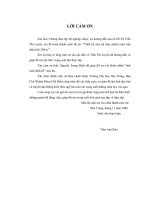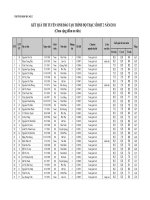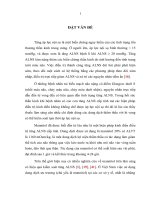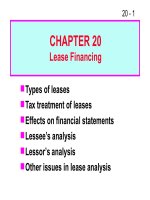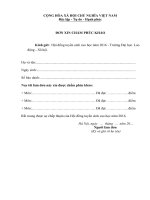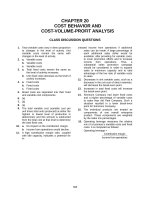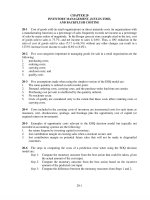Accounting26th ch 20
Bạn đang xem bản rút gọn của tài liệu. Xem và tải ngay bản đầy đủ của tài liệu tại đây (533.01 KB, 20 trang )
CHAPTER
Process Cost Systems
Warren
Reeve
Duchac
©2016
human/iStock/360/Getty Images
Accounting
26e
Process Cost Systems
•
A process manufacturer produces products that are
indistinguishable from each other using a continuous production
process.
o
o
•
The cost accounting system used by process manufacturers is called the
process cost system.
A process cost system records product costs for each manufacturing
department or process.
A job order manufacturer produces custom products for
customer or batches of similar products.
o
o
The cost accounting system used by process manufacturers is called the
job order cost system.
A job order cost system records product cost for each job, using job cost
sheets.
©2016
Comparing Job Order and
Process Cost Systems
• Process and job order cost systems are different in
several ways:
o
o
A process cost system accumulates (records) product costs in
work in process accounts for each department. In contrast, a
job order cost system accumulates (records) product costs by
jobs, using job cost sheets.
In a job order cost system, the work in process at the end of
the period is the sum of the job cost sheets for partially
completed jobs. In a process cost system, the work in process
at the end of the period is the sum of the costs remaining in
each department account at the end of the period.
©2016
Cost of Production Report
(slide 1 of 3)
• In a process cost system, the cost of units transferred
out of each processing department must be
determined along with the cost of any partially
completed units remaining in the department.
o
The cost of production report summarizes the production
and cost data for a department as follows:
The units the department is accountable for and the disposition of
those units.
The product costs incurred by the department and the allocation of
those costs between completed (transferred out) and partially
completed units.
©2016
Cost of Production Report
(slide 2 of 3)
• A cost of production report is prepared using the
following four steps:
o
o
o
o
Step 1. Determine the units to be assigned costs.
Step 2. Compute equivalent units of production.
Step 3. Determine the cost per equivalent unit.
Step 4. Allocate costs to units transferred out and partially
completed units.
©2016
Cost of Production Report
(slide 3 of 3)
• Preparing a cost of production report requires making
•
a cost flow assumption.
Like merchandise inventory, costs can be assumed to
flow through the manufacturing process using the firstin, first-out (FIFO), last-in, first-out (LIFO), or average
cost methods.
o
Because the first-in, first-out (FIFO) method is often the
same as the physical flow of units, the FIFO method is used
in this chapter.
©2016
Compute Equivalent Units of Production
• Whole units are the number of units in production
•
•
during a period, whether completed or not.
Equivalent units of production are the portion of
whole units that are complete with respect to either
materials or conversion (direct labor and factory
overhead) costs.
Equivalent units for materials and conversion costs are
usually determined separately.
o
This is because materials and conversion costs normally
enter production at different times and rates.
©2016
Determine the Cost per Equivalent Unit
• The direct materials and conversion costs per
equivalent unit are computed as follows:
©2016
Allocate Costs to Units Transferred
Out and Partially Completed Units
• Product costs must be allocated to the units
transferred out and the partially completed units on
hand at the end of the period.
o
The product costs are allocated using the costs per
equivalent unit for materials and conversion costs that were
computed in Step 3.
©2016
Preparing the Cost of Production Report
• A cost of production report is prepared for each
•
processing department at periodic intervals.
The report summarizes the following production
quantity and cost data:
o
o
The units for which the department is accountable and the
disposition of those units
The production costs incurred by the department and the
allocation of those costs between completed (transferred
out) and partially completed units
©2016
Frozen Delight’s Cost Flows
©2016
Yield
• In addition to unit costs, managers of process
•
manufacturers are also concerned about yield.
The yield is computed as follows:
Quantity of Material Output
Yield =
Quantity of Material Input
©2016
Just-In-Time Processing
• Just-in-time (JIT) processing is a management
•
approach that focuses on reducing time and cost and
eliminating poor quality.
A JIT system obtains efficiencies and flexibility by
reorganizing the traditional production process.
©2016
Traditional Production Process
• With a traditional manufacturing process, workers are
•
assigned a specific job, which is performed
repeatedly as unfinished products are received from
the preceding department.
The product moves from process to process as each
function or step is completed.
©2016
Traditional Production Line
©2016
Just-In-Time Production Process
(slide 1 of 2)
• In a just-in-time system, processing functions are
combined into work centers, sometimes called
manufacturing cells.
o
These work centers complete several functions. Thus, workers
are often cross-trained to perform more than one function.
• The activities supporting the manufacturing process
•
are called service activities.
In a JIT manufacturing process, service activities may
be assigned to individual work centers, rather than to
centralized service departments.
©2016
Just-In-Time Production Process
(slide 2 of 2)
• In a JIT system, the product is often placed on a
movable carrier that is centrally located in the work
center. After the workers have completed their
activities with the product, the entire carrier and any
additional materials are moved just in time to satisfy
the demand or need of the next work center.
o
In this sense, the product is said to be “pulled through.”
• Each work center is connected to other work centers
through information contained on a Kanban, which is a
Japanese term for cards.
©2016
Just-In-Time Production Line
©2016
Appendix: Determining Costs
Using the Average Cost Method
• Under the average cost method, all production costs
(materials and conversion costs) are combined
together for determining equivalent units and cost per
equivalent unit.
©2016
Cost of Production Report for S&W’s
Mixing Department—Average Cost
©2016

